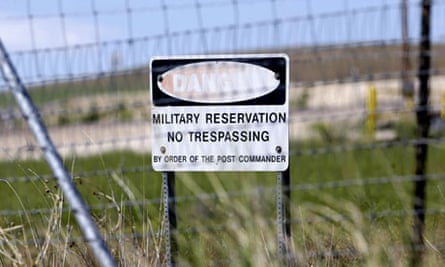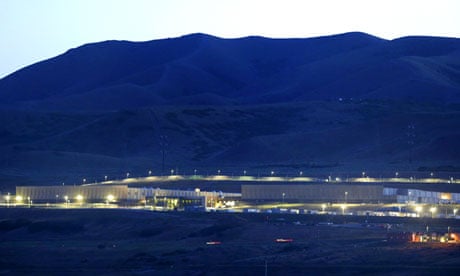Drive south down Camp Williams Road, a highway outside Salt Lake City, and your eye is drawn to the left. A gun-mounted helicopter and other military hardware marks the entrance of the Utah army national guard base. The ice-capped Rockies soar in the distance.
To the right there is little to see: featureless scrubland, a metal fence, some warehouses. A small exit – not marked on ordinary maps – takes you up a curving road. A yellow sign says this is military property closed to unauthorised personnel.
Further up the hill, invisible from the highway, you encounter concrete walls, a security boom and checkpoint with guards, sniffer dogs and cameras. Two plaques with official seals announce the presence of the office of the director of national intelligence and the National Security Agency.
A spokesperson at NSA headquarters in Maryland did not welcome a Guardian request to visit its western outpost. "That is a secure facility. If you trespass on federal property security guards will be obliged to do their jobs." An interview was out of the question.
Welcome to the Utah Data Center, a new home for the NSA's exponentially expanding information trove. The $1.7bn facility, two years in the making, will soon host supercomputers to store gargantuan quantities of data from emails, phone calls, Google searches and other sources. Sited on an unused swath of the national guard base, by September it will employ around 200 technicians, span 1m sq ft and use 65 megawatts of power.
This week Utah roasted in near-record temperatures ideal for fires and thunderstorms, putting the state under a hazardous weather outlook advisory. The NSA could have done with a similar warning for the scorching criticism of its surveillance activities, a sudden reversal of scrutiny for the agency and its Utah complex.

Deep in Mormon country between the Wasatch and Oquirrh mountains, nestled on the outskirts of Bluffdale (population 7,598), it was designed to be largely anonymous. Instead, after Guardian disclosures of data-mining programs involving millions of Americans, the Utah Data Center provokes an urgent question: what exactly will it do?
The NSA says it will not illegally eavesdrop on Americans but is otherwise vague. Its scale is not in doubt. Since January 2011 a reported 10,000 labourers have built four 25,000-sq ft halls filled with servers and cables, plus an additional 900,000 sq ft of space for technical support and administration. Generators and huge fuel and water tanks will make the site self-sustaining in an emergency.
Outside experts disagreed on the centre's potential. Some said it will just store data. Others envisaged a capacity to not just store but analyse and break codes, enabling technicians here to potentially snoop on the entire population for decades to come.
William Binney, a mathematician who worked at the NSA for almost 40 years and helped automate its worldwide eavesdropping, said Utah's computers could store data at the rate of 20 terabytes – the equivalent of the Library of Congress – per minute. "Technically it's not that complicated. You just need to work out an indexing scheme to order it."
Binney, who left the agency in 2001 and blew the whistle on its domestic spying, said the centre could absorb and store data for "hundreds of years" and allow agencies such as the FBI to retroactively use the information.
He said the centre will likely have spare capacity for "brute force attacks" – using speed and data hoards to detect patterns and break encrypted messages in the so-called deep web where governments, corporations and other organisations keep secrets. There would be no distinction between domestic and foreign targets. "It makes no difference anymore to them."
James Bamford, author of The Shadow Factory: The Ultra-Secret NSA from 9/11 to the Eavesdropping on America, said the public had yet to grasp the significance of Utah's data-mining. "It's basically a hard-drive. It's also a cloud, a warehouse. It'll be storing not just text and audio but pictures and video. There's a lackadaisical attitude to this. People pay no attention until it's too late." Bamford wrote a cover story about the centre for Wired last year.
Brewster Kahle, a co-founder of the Internet Archive, a San Francisco-based non-profit that hoovers up knowledge in a digital equivalent of the library of Alexandria, said technology facilitated near-ubiquitous snooping. "If one had the opportunity to collect all the voice traffic in the US it would cost less than the Pentagon spends on paperclips. Storage these days is trivial, it's not a problem."
A rack of servers the size of a fridge can store 100 TV channels' annual output, said Kahle. "What's slow to dawn on people is that this level of surveillance is technologically and economically within our grasp."
Some, however, disputed the image of Utah as an insatiable data Kraken. It will have no "operational function" – no eavesdropping or codebreaking – and will struggle to store data exploding from ever-expanding use of the internet, smartphones and tablets, said Matthew Aid, an intelligence historian and author of The Secret Sentry: The Untold History of the National Security Agency.
"The intelligence people I've spoken are warning of data crunch – a polite way of saying they're drowning. They say they don't have enough capacity and will be back to Congress looking for more money to expand." If so the site can do so. "It's designed to be modular, you can add clip-ons. There is plenty of land."

Utah has a colourful history of data management. Pony Express riders such as Buffalo Bill used to gallop through its deserts with sacks of mail dodging peril. "Must be expert riders, willing to risk death daily. Orphans preferred," said the famous – and possibly apocryphal – jobs advert. Mormons have long stored microfilms and documents in excavated chambers known as the Granite Mountain Vault.
The NSA chose the state apparently for a more prosaic reason: cheap electricity. It also helped that its conservative politicians, notably Senator Orrin Hatch, who served on the senate intelligence committee, supported post-9/11 security measures.
Revelations about surveillance programs such as Prism and Boundless Informant caused a small backlash this week. Several dozen people rallied outside the state capitol in Salt Lake City complaining of constitutional violations. "It's just plain creepy!" said one placard. Others cited the fourth amendment and George Orwell's novel 1984. Local newspapers' op-ed pages also fulminated.
Others, however, have seen opportunity in the NSA's arrival. The University of Utah has created a data-management course for students in consultation with the agency, which has promised internships at the data centre.
Officials in Bluffdale shrugged off privacy concerns. "They're not a very open entity but if someone reads my emails they'll be pretty bored," said Mark Reid, the city manager. A deal to extend utilities to the centre, and to recycle water, helped open up scrubland for commercial development, he added. "It's win-win."
The NSA rejected a request from county mayors to tour the perimeter last month but Bluffdale's mayor, Derk Timothy, was not offended. "I've never been inside the fence but it's kind of to be expected with a facility like that."
Revelations about surveillance did not prove abuse of power, he said. "I don't think they crossed the line. They've been good partners to us, especially when it comes to water." The NSA was now part of the landscape. "They've been building that facility as if they're going to stay forever."

Comments (…)
Sign in or create your Guardian account to join the discussion